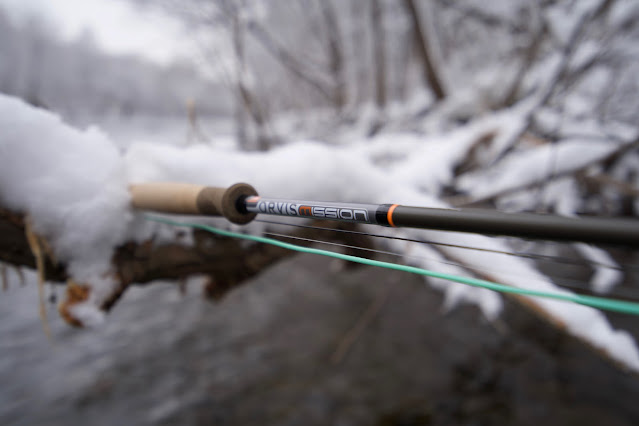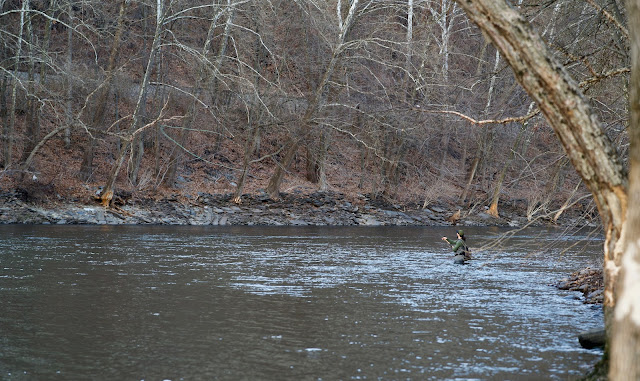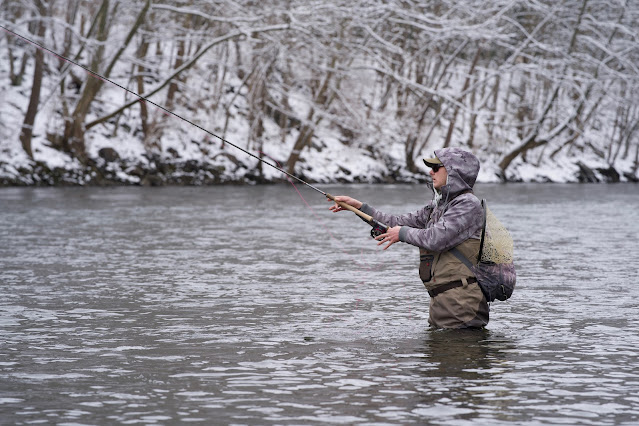Orvis Mission 5120 Trout Spey Rod
Grain Window: 300-420
4-5-6
Line Recommendations
- Scandi: Rio Elite Scandi Launch (320gr.) or Rio Scandi Short (330gr.)
- Hybrid: Airflo Rage Compact (330gr.) or Rio Trout Spey #5 (350gr.)
- Skagit: Rio Elite Skagit Max Power (375gr.)
- Traditional Skagit: Rio Elite Skagit Max Launch (400gr.) or Bridge Torrent (375gr.)
- Mid-Belly: Bridge Tributary 4/5 (425gr.)
Over the last several years, I've predominantly fished trout spey rods on the major river systems and streams of eastern Pennsylvania. After my first two handed rod in 2009, it was only natural to take the techniques I practiced on the Great Lakes tributaries and move them to my local haunts. Since then, the industry has created a "trout spey" monster with specific rods and a myriad of lines to cater to this demographic of anglers. I've fallen so far down this rabbit hole that my buddy Ryan has begun to describe me as a "one trick pony". Out of this obsession, I began looking for a rod that bridged the gap between the short spey rods designed for steelhead and the trout spey specific offerings on the market.
The search requirements included the need for a rod with more length and power while still maintaining a certain degree of finesse when a 16" trout takes your fly. These ideas arose out of swinging larger rivers with a 11" 3 or 4wt. rods attempting to fish flies on the larger side (3" +). When you add in deeper water, heavy winds, and distant lies, most will struggle under those conditions. I decided that a longer rod between 12' and 12' 6" would allow greater control while the extra grains of a 5wt. would take the burden off the rod when tossing a 4" articulated sex dungeon. The length and power would also come in handy while swinging, or stripping, flies at long range. The tricky part with this situation is finding a rod that does not overpower trout. Almost every major manufacturer now makes a 5120 (Sage, Orvis, G. Loomis, Winston, Beulah, and others) or slightly longer, higher end models from the likes of C.F. Burkheimer, Meiser, or Anderson Custom Rods. After reaching out to an Orvis representative, I had an opportunity to try out their new (ish) Mission series and the 5120.
Orvis markets the Mission 5120 as part of their trout spey series, which also features an 11' 4" 3wt. and 4wt. Other than the difference in length, the 5120 has longer rear and fore grips compared to the smaller rods in the lineup. The length and grain weight make it a tweener rod between the trout and steelhead realms. Orvis describes the 5120 as a, "heavy trout spey rod," to be used "with streamers and larger flies in big water". With those types of characteristics and descriptions, the rod seemed to be exactly what I was looking for. After unpacking and examining it, I immediately sensed the power inherent in the rod. It felt more like my Loop Cross S1 7120 (which is a 6.5 wt.) than my current trout spey arsenal. I found it balanced perfectly with the Orvis Battenkill Spey IV which weighs 8.9 ounces. It also matched up well with my Loop Multi 6-9 at 9.17 ounces. Orvis is pretty notorious at not sharing the weights of their fly rods. In this case, I wouldn't call the rod light, but it isn't heavy either. After a full day of casting and fishing, I was not fatigued. When properly balanced, it feels light in hand.
Cosmetically, the Mission series fits into the current style employed across each series of Orvis rods. There is a distinct graphic label above the cork that identifies the make, model, and line size. Some have begun to describe Orvis as the "Taylormade of fly rods". Most people either love or hate this. If you're in my shoes, you really don't care what the rod looks like. On the Mission series, the label is less "in your face," compared to the all white label on the original H3 models. It has a distinct "Mission" logo in gray, white, and orange accents. The blank is an olive color with a sparkle to it. In appearance, the rod closely resembles the Recon series and has the same pewter reel seat. The cork is definitely higher end and hasn't shown any signs of early wear and tear. Orvis gets some bonus points here for adding composite cork to each of the handle's ends. This is a feature I'd like to see on the Recon and H3 series to add durability and a better appearance. Another nice touch is a down-locking reel seat, which makes it easier to balance the rod. Chrome snake guides with SiC inserts complete the package. These features sit firmly between the Recon and H3 lineups and I'm curious to know whether the material package within the blank more closely resembles the H3 or the Recon. In my opinion, it feels more like the Recon than the H3. The price point also reflects that.
After casting and fishing the 5120, I'm not sure I would classify it as a trout spey rod but more as a short spey rod that can be used to fish for larger trout. This is one powerful fast action rod that plays more like a 5.5 wt. Like most modern rods, it features a large grain window (300-420 gr.) to suit a variety of different casting styles and load preferences. The rod features a soft tip and stiff bottom section that enables it to engage the top third of the rod. This works for a quick underhand stroke that can tight loops that cut through wind, but is better suited for a skagit and tossing larger sculpin patterns for trout and small steelhead.
For scandi lines, anglers should focus on the lower end of the grain window between 300-330 grains. For hybrid lines that bridge the gap between scandi and skagit styles, I'd operate in the middle range of the grain window. For short (OPST styled) skagit heads, 360 grains seems to be the sweet spot. For more traditional skagit lines, focus on the upper end of the spectrum between 360-420 grains. One can also adjust the length and the grain weights of your tip systems to dial in the system more. Simply put, you can find a line that will work for you.
Line Recommendations
- Scandi: Rio Elite Scandi Launch (320gr.) or Rio Scandi Short (330gr.)
- Hybrid: Airflo Rage Compact (330gr.) or Rio Trout Spey #5 (350gr.)
- Skagit: Rio Elite Skagit Max Power (375gr.)
- Traditional Skagit: Rio Elite Skagit Max Launch (400gr.) or Bridge Torrent (375gr.)
- Mid-Belly: Bridge Tributary 4/5 (425gr.)
My favorite part of the rod is the power reserve deep in the lower end of the blank. I don't have to be worried about being limited if I want to stretch out to a distant lie or throw a larger fly when the bite is slow. Every time I tried pushing this rod further with a heavier line, or a more aggressive d-loop, it handled it. With this rod, my predominate focus was skagit, and will be skagit moving forward, but after seeing how well it casted underhand, I'm looking forward to the dry line opportunities it will provide.
The rod's achilles heel is the general lack of feel in the lower third of the rod. This means that the rod lacks definitive feedback through the cork that anglers can feel in their hands. This is a problem that most rods with similar tapers share. When it comes to feel in the cork, fast action rods can sometimes be an emotionless casting experience. The special fast action rods are those that can create feeling into the cork. With this in mind, anglers that are just getting started with casting a two hander may struggle with a Mission rod. To make a comparison to golf, this is not a game improvement iron. It is a tour iron that requires precise timing and technique. Beginning anglers that are looking for the rod to tell them when it is loaded, especially during the formation of a d-loop, aren't going to have the same type of sensation compared to a more progressive or slower rod taper. Secondly, the rod, and other Missions I've casted (4114, 8110), have a soft tip. It isn't the best at lifting a heavy sink tip out of the water to go directly into a sustained anchor cast. With shitty technique, the soft tip can produce some wonkiness on the forward delivery. For high level scandi casters, they probably will not like the softness in this tip compared to more traditional scandi rods and tapers.
Overall, this is the best two handed Orvis rod that I've casted. The rod feels light in hand, has an immense power reserve, and is highly accurate when you need to place a sculpin along a specific holding lie. It is a better skagit rod than scandi rod due to the rod's taper and soft tip. However, proficient two handed casters will not be limited in any shape or form while using this on the water. It has power in spades that will be able to tackle a wide variety of species. If you're someone that is looking for one rod to fish smaller Great Lakes tributaries and also swing for trout, this might be a solution for your intended quarry.
With Orvis's next two handed series, I'd like to see them lean more into the H4 technology. If that technology minimizes rod vibration, and improves tracking, at all levels of the cast, they should be able to produce a supreme two handed taper that has the opposite taper compared to the Mission series. I'd like to see them produce a rod with a strong tip that bends deeper the closer you get to the cork. This will allow feel and a deeper load while maximizing recovery speed. The recovery of the rod tip, combined with H4 tech, should be special. This is my wish...
For casting videos, check out my mini-review on Instagram (click). For a detailed breakdown of the lines that I tested, continue reading below.
Line Recommendations
- Scandi: Rio Elite Scandi Launch (320gr.) or Rio Scandi Short (330gr.)
- Hybrid: Airflo Rage Compact (330gr.) or Rio Trout Spey #5 (350gr.)
- Skagit: Rio Elite Skagit Max Power (375gr.)
- Traditional Skagit: Rio Elite Skagit Max Launch (400gr.)
The line list that I've casted and fished with the Orvis Mission 5120.
Scandi:
- Rio Steelhead Scandi at 310 grains and 31 ft.
- This is an older generation of line. With a mono, or light polyleader, I found this line matched up well with the faster action and tip flex of the 5120. An angler can produce high line speeds and sharp loops that can cut through wind. With that being said, I felt that this line was a little light. If I were to buy a new line for the rod, I would get the newer Rio Scandi Short at 330 grains and 31 ft.
- Rio Scandi Short 330 gr. or Rio Elite Scandi Launch at 320 gr.
- Having finally purchased/fished this line, this is definitely the 5120's perfect scandi line.
- Rio recently updated this line to the Rio Elite Scandi Launch. Based on that lines profile, I'd recommend the 320gr.
- Orvis Mission Scandi at 300 gr. (24 ft.) and 360 gr. (25 ft.)
- I would not classify these two as scandi lines, but as hybrids that bridge the gap between the two systems. I enjoy the ease at which both of these lines cast mono and light polyleaders. They also offer a lot of versatility to fish heavier tips up to T-8. Orvis recommends the 300 gr. for the rod but I found it to be too light. I preferred the load of the 360 gr. version more and the added ability to fish heavier tips.
- Airflo Rage Compact @ 330 gr. and 27.5 ft.
- As a hybrid that leans to the scandi spectrum, the 330gr. may be a one line fits all shooting head solution to the 5120. It will work perfectly as a scandi substitute on windy days and double as a light skagit to throw light/medium sized streamers.
- Rio Integrated Trout Spey #5 350 gr.
- If you wanted one line to trout spey, swing/strip streamers, and fish soft hackles, this is your best bet. For what its worth, this is the same exact line as the Scandi Body below and the same profile/length as the old Rio Scandi Versitip from a decade ago. Minimal changes.
- Rio Scandi Body at 400 gr. and 23 ft.
- This is definitely exploring the upper reaches of the rod's grain window, especially when paired with a piece of T-8. This line is highly recommended by the Ashland Fly shop on the Sage X 5120 so I was interested in trying it out for this rod. This was one of the only lines I tried where felt the rod into the cork, albeit with some negative pushback from the blank. When slowing the casting stroke down, anglers can really launch this line. If I were to buy another, I would definitely opt for the 350 gr. version. See the trout spey above.
Short Skagit:
- Orvis Mission Skagit in 360 gr. and 15.5 ft.
- In this short length, the Mission skagit packs a considerable amount of punch in a tiny package. This line creates a lot of surface tension to create solid anchors capable of loading the road and launching large flies on T-8-T-11 tips. I found this to be an ideal short skagit line pairing for the rod. However, this line leaves a lot to be desired with the color choice. For a rod that generally lacks sensory feedback in the hands, anglers can get feedback from their loop formations. With the dark olive color, this line is virtually invisible in the air and on the water. For trout spey situations that call for movement on the fly and adapting to complex currents, it can be difficult to tell what is going on and how to respond to it.
- OPST Commando Smooth at 300 gr.
- This once was the heaviest offering in OPST's Smooth lineup and it is also their recommendation for most of the 5120's on the market. I found it to be too light, which makes sense considering how much I liked the 360 gr. Mission Skagit. If I were to employ this line, I would even the gap by adding OPST's 132 gr. sink tips. With OPST launching new Commando Smooth models recently, I'd opt for the 350gr. model.
- OPST Commando Groove at 350 gr.
- I found this to be an easy casting line capable of handling most of the larger flies I wished to throw. This would be a line that I would employ to fish medium sized flies in very cold water conditions in order to slow things down and give lethargic fish time to find a meal.
Skagit:
- Rio Elite Skagit Max Power Integrated in 375gr.
- This is the line I settled with after trying all of the other skagit lines on this list and is my highest recommendation for trout spey streamer fishing. It loads the Mission well without any pushback from the blank and can still launch my largest trout spey streamers with ease. The only downside to this line is that it has a triple step down off the rear. To maximize its casting efficiency, be sure to have a little extra hang down off the tip. Go beyond the dark blue transition to get that loaded D-Loop and energy transfer into the forward cast.
- Airflo Skagit Switch in 360 gr. and 420 gr.
- This is an older line that I always liked for fishing the "switch" rods on the market prior to the trout spey transition that has taken place. The 360 gr. version was the first line I thought of trying because I've employed it on two other 5-6 weight switch rods that I own. In general, I found it to be a little light at accessing the power reserve of the rod. I also already owned a 420 version and found that to be a much better line for the 5120.
- SA Spey Lite Integrated Skagit in 420 gr.
- SA offers this integrated skagit in 360, 390, and 420 gr. offerings. At the time, I opted for the 420 gr. over the 390 grain because it is 21 ft. long. That extra length comes in handy on larger bodies of water and will eliminate several extra strips (line management issues) while also granting greater control over the fly at distance. This is a big water skagit line. One key to making this line work is to have a little extra overhang out of the rod tip. You can see that the entire section of black line is out of my rod here. A downside to this line is that it doesn't work well with the rod in short casting situations.














No comments:
Post a Comment